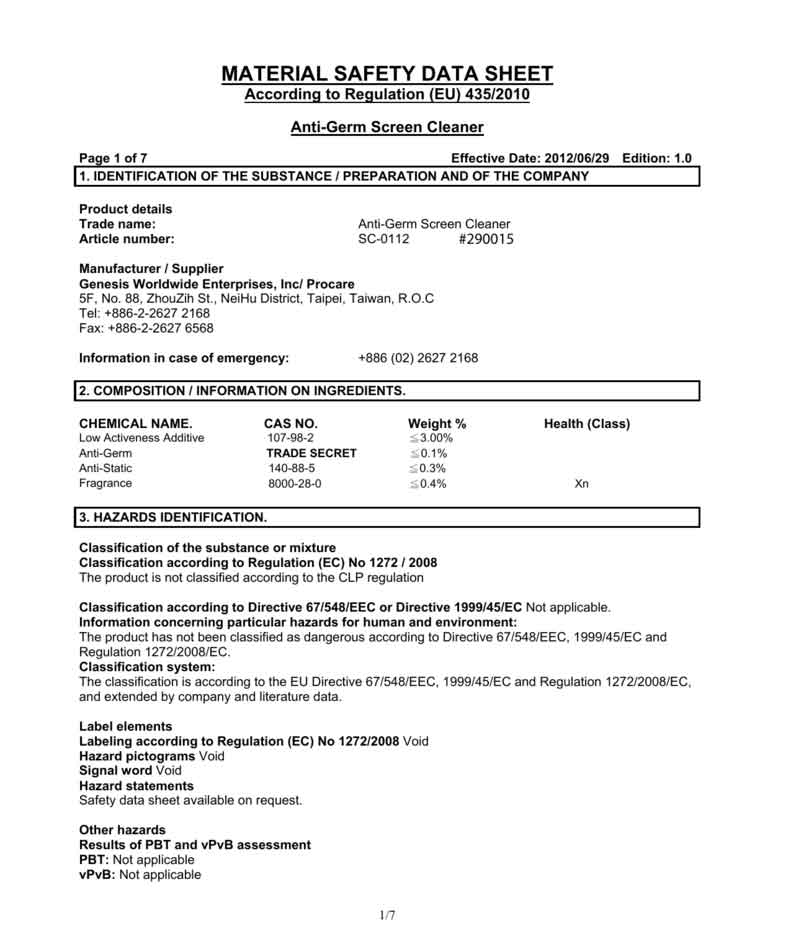To ensure the safe transport of hazardous or potentially hazardous goods, an MSDS (Material Safety Data Sheet) is essential for all such shipments.
Continue reading to learn more about shipping MSDS requirements.
What is MSDS in shipping?
A Material Safety Data Sheet documents the hazardous materials‘ physical, radioactive, chemical, and explosive properties.
The exporter or manufacturer typically provides the MSDS full form, including a UN Number.
An MSDS certificate helps determine the additional costs of shipping hazardous goods. It ensures that the carrier can follow related safety protocols during handling and that the shipment does not exceed vessel safety limits.
Typically, freight forwarders require the MSDS to be submitted along with the Shipper’s Letter of Instruction.
Example of MSDS certificate:

What items need an MSDS in shipping?
Electronics devices
Shipping electronic items is subject to restrictions, primarily because they often include batteries that require special handling.
An MSDS certificate is always essential for delivering lithium batteries, whether deemed hazardous or not.
Furthermore, batteries must be removed from electronics before shipping as it can cause sparks and increase the fire risk.
Liquids
Transporting any liquid requires an MSDS. This document must provide a thorough breakdown of the liquid’s chemical makeup.
For instance, when a company ships products like paint or non-alcoholic hand sanitizer, the MSDS should detail properties like boiling point and flammability.
Powders
Shipping powders, such as beauty powders, can come with restrictions due to their potential reactivity under various conditions. The MSDS report must file the powder’s stability and physical and chemical properties.
While not every item requires an MSDS, flammable goods must have one to be shipped as general cargo. You can contact our shipping expert with your cargo details to see if a Material Safety Data Sheet is needed.
What information does the MSDS include?
Generally, a Material Safety Data Sheet gives information about:
- Identification of the substance or mixture and associated hazards.
- Chemical composition and ingredient details.
- Instructions for firefighting in case of a fire.
- First aid measures for injuries caused by the substance.
- Steps to contain or minimize damage in case of accidental release.
- Handling and storage criteria and guidelines.
- Methods for personal protection and exposure control.
- Information on the chemical and physical properties of the mixture.
- Details about the toxicity of the material.
- Transport and regulatory information.
- Ecological impact and disposal instructions.
- Additional details on the MSDS preparation and revision.
How can I obtain an MSDS certificate?
1. Check with the supplier
The most direct way is to contact the product manufacturer or supplier to request an MSDS report. Most companies have this document on hand, as it is a legal requirement in many countries.
2. Online resources
You can search online databases if the manufacturer or supplier cannot provide the MSDS document. Many websites are dedicated to offering MSDS information for various products and chemicals. Some well-known databases include MSDSonline and Chemwatch.
Sometimes, government agencies that regulate hazardous substances can provide the shipping MSDS. For instance, the Occupational Safety and Health Administration (OSHA) maintains a database of MSDS for various chemicals in the United States.
What is the difference between MSDS and SDS?
Material Safety Data Sheet:
Used primarily in the U.S. before adopting the Globally Harmonized System (GHS). There is no standardized format, and it may vary across countries and organizations.
Safety Data Sheet(SDS):
It conforms with the GHS standard and follows a standardized 16-section format covering hazard identification, first-aid measures, accidental release measures, and more. This uniform structure ensures that all necessary information is included and presented consistently.
In summary, while both MSDS and SDS reports serve the same purpose of providing safety information about DG cargo, the SDS follows a globally standardized format that enhances clarity and compliance.
How to ship hazardous materials smoothly?
From planning to execution, Airsupply offers tailored solutions for all your shipping needs, including handling dangerous goods, to ensure smooth and efficient transportation.
Furthermore, we navigate the complexities of customs clearance and ensure that all required paperwork, including MSDS, to prevent any potential issues.
FAQs of MSDS in shipping
Can I reuse an MSDS report?
This document can only be reused for recurring shipments if the hazardous material remains identical. For instance, the same MSDS certificate can apply to a lithium battery used in various products, provided it is the same battery. Additionally, the MSDS must accompany every shipment to certify that the hazardous material has not changed.
Does it cost to prepare an MSDS? If so, how much?
The expense varies based on the lab or testing company you hire, as there is no standard rate. On average, the cost ranges from $100 to $500 or more per MSDS, depending on the complexity and thoroughness of the report.
Who pays for the MSDS report?
The manufacturer/supplier.
What if I cannot obtain an MSDS?
If you can’t acquire an MSDS, you may face substantial delays. Customs might hold your shipment until the needed documentation is provided. Additionally, you could incur fines, storage fees, or even costs for returning the shipment.




